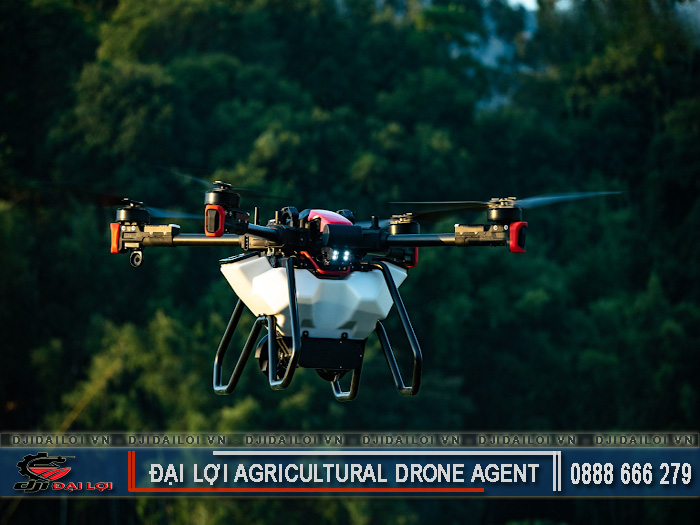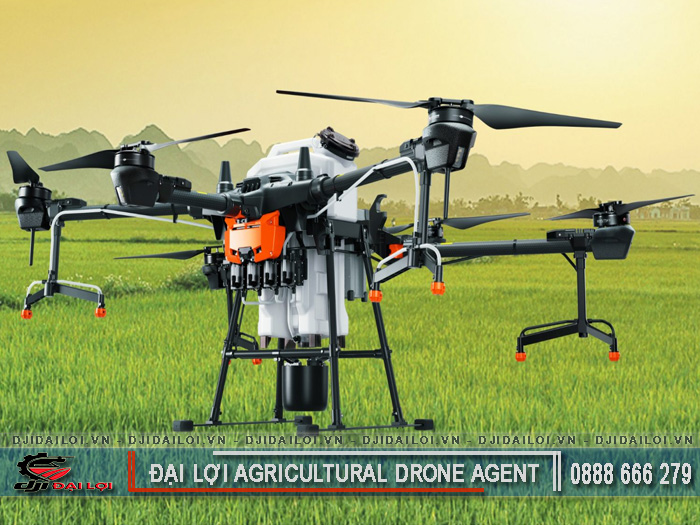
What is an agricultural drone?
As unmanned technology reshapes modern production, many people wonder, “What exactly is an agricultural drone, and is it really necessary for Vietnamese farmers?” More than just a flying device, it represents the future of smart agriculture where humans are freed from heavy, hazardous labor through the precise assistance of drone technology.
Definition of an agricultural drone
An agricultural drone is an unmanned aerial vehicle (UAV) designed specifically for farming tasks such as spraying pesticides, spreading fertilizers, sowing seeds, and crop monitoring. The device uses GPS, sensors, mapping, and artificial intelligence to operate automatically or semi-automatically along pre-programmed routes.
Extended concept and usage context
Also known as a farming drone, it plays a vital role in precision agriculture. Unlike manual methods, it provides uniform application, dosage control, and reduced waste particularly effective in spraying or seeding across challenging terrains such as terraced fields, wetlands, or vast farmlands.
Drone technology is already being widely used in advanced agricultural nations such as Japan, China, and the United States, and is expanding rapidly in Vietnam across cooperatives and mid- to large-scale farms. Thanks to its flexibility and outstanding efficiency, the agricultural drone not only assists farmers but also reduces environmental pollution and protects community health by limiting direct contact with agrochemicals.
Structure and working principle of agricultural drones
More than a “flying sprayer,” an agricultural drone is an integrated high-tech system that enables accurate, stable, and safe operation. Understanding its structure and working principles allows users to optimize performance and avoid operational errors.
Main components of an agricultural drone
- Frame: Supports the entire device, typically made of lightweight materials like carbon fiber or aluminum alloy. Designed in X, H, or multi-arm shapes depending on model type.
- Propellers and motors: Usually equipped with 4-8 brushless motors and large propellers to ensure strong lift and stable movement, even in light winds.
- Tank and spraying/spreading system: Depending on function, the tank may hold pesticides, fertilizers, or seeds. High-pressure nozzles or centrifugal spreaders ensure even, precise distribution.
- Flight control unit (FCU) and GPS: The brain of the drone that processes flight signals and uses GPS navigation for accurate routing and obstacle avoidance.
- Cameras, sensors, and image transmission system: Provide real-time monitoring, identify spray zones, and measure distance, altitude, and terrain for automatic adjustment.
Operating principle
Agricultural drones follow a “map-operate-spray” principle:
- Operators use mapping software (on smartphones or tablets) to outline farm areas and flight paths.
- The drone relies on GPS and altitude sensors to fly accurately and maintain a safe distance from crops.
- During operation, pressure-controlled nozzles adjust flow according to speed, wind direction, and crop density, ensuring efficient, even application.
- High-end models feature intelligent obstacle avoidance, weed detection, and adaptive spray modes.
With modern construction and automated operation, agricultural drones not only replace manual labor but also deliver uniformity, precision, and superior efficiency in crop management.
Common classifications of agricultural drones
By function:
- Spraying drones: The most common type, using high-pressure nozzles to evenly apply pesticides, herbicides, or fungicides. DJI agricultural drones, such as the DJI Agras series, are leading examples that combine precision spraying with AI-assisted flight control. Tank capacity ranges from 10–30 liters, offering far greater efficiency than manual spraying.
- Spreading/sowing drones: Equipped with centrifugal or slot-type dispensers for seed or fertilizer distribution ideal for early-season planting.
- Monitoring drones: Outfitted with multispectral cameras and NDVI sensors to track crop health, detect pests, or identify dry zones often used by large enterprises or research centers.
By capacity and coverage area:
- Mini drones (≤ 10 L): Suited for smallholders, narrow fields, and terraced farms. Lightweight, easy to use, and affordable.
- Medium drones (12-20 L): Designed for cooperatives or mid-size farms, covering 5-10 hectares per day with both spraying and spreading functions.
- Large drones (≥ 25 L): Used by large farms or agribusinesses, achieving over 20 hectares per day with advanced automation features.
By control mechanism:
- Semi-manual control: Operators handle flight direction and spray timing using a remote controller suitable for beginners.
- Fully autonomous control: Based on pre-mapped GPS routes, drones fly and spray automatically while operators supervise remotely now the mainstream choice for accuracy and labor savings.
This clear classification helps users choose the right configuration, avoid unnecessary investment, and maximize operational efficiency.
Advantages and disadvantages of agricultural drones
Key advantages
- Higher labor productivity: A 20 L drone can spray 15-20 hectares per day 30-50 times faster than manual labor.
- Material savings: Smart sensors ensure accurate dosage and targeting, reducing chemical and fertilizer use by 20-30 %.
- Health protection: Operators avoid direct exposure to toxic chemicals, reducing poisoning and respiratory risks.
- Crop loss reduction: Uniform spraying, even in hard-to-reach areas, improves pest control effectiveness.
- High automation: AI-powered models with terrain sensors and obstacle-avoidance radar deliver flexible, precise operations.
Limitations to consider
- High initial investment: Basic models cost VND 80-200 million, excluding accessories and maintenance.
- Technical skill requirement: Operators must learn mapping, flight planning, and maintenance.
- Weather constraints: Strong winds or rain can affect spray accuracy and flight stability.
- Limited flight time: Each battery lasts 15-25 minutes, requiring frequent swaps for large areas.
- Unsuitable for very small or steep plots: Efficiency and cost-effectiveness drop in fragmented terrains.
Despite these limitations, the clear advantages in productivity, efficiency, and safety make agricultural drones a worthwhile investment for modern farming models.

Roles, applications and real-world value of agricultural drones
With rural labor declining and wages rising, cooperatives and large farms must innovate. Agricultural drones have evolved from experimental tools into practical solutions for improving efficiency, cutting costs, and protecting the environment.
Practical applications
- Pesticide, herbicide, and fungicide spraying: The most widespread use low-altitude, adjustable-speed spraying ensures even coverage with minimal waste and environmental leakage.
- Seed sowing and fertilizer spreading: Specialized drones can sow rice, corn, beans, and fertilizer within hours instead of days.
- Crop monitoring and growth analysis: Multispectral imaging and NDVI data enable early detection of stress zones and precision irrigation or fertilization.
- Use in special terrains: In mountainous or terraced regions where heavy machinery cannot access, drones are indispensable tools.
User benefits
- Long-term cost savings: Although expensive upfront, most farmers recover costs within one or two seasons through reduced labor and chemical expenses.
- Labor independence: One operator can manage multiple drones using a single device.
- Data-driven precision: AI analytics replace guesswork with real-time decision-making.
- Environmental protection: Reduced chemical runoff protects soil and water quality.
- Driving smart agriculture: A key step in Vietnam’s agricultural digital-transformation strategy.
Who should use agricultural drones?
- Cooperatives growing rice, vegetables, or industrial crops larger than 10 ha.
- Farms following GlobalG.A.P., VietGAP, or organic standards.
- Service providers offering contract spraying.
- Export-oriented agribusinesses requiring precise pesticide-residue control.
Common misconceptions and cautions
“Just buy it and fly” - a costly mistake
Many assume drones are plug-and-play, but most models require technical knowledge: mapping, weather assessment, flight calibration, and spray-rate adjustment. Without proper training, efficiency plummets and crop damage can occur.
“All drones are the same cheaper is better” - false assumption
The market hosts dozens of models from tens to hundreds of millions of dong, each with different specs: capacity, wind resistance, nozzle type, speed. Choosing the wrong one wastes money or mismatches your terrain.
“No need for field inspection” - misguided thinking
Drones are tools, not replacements for agronomic observation. Overreliance can cause missed early-warning signs of pests or nutrient issues.
“No regular maintenance needed” - high risk of failure
Neglecting post-season maintenance checking propellers, motors, batteries, and nozzles can lead to in-flight failures, reduced performance, and shorter lifespan.
Understanding agricultural drones is the key to applying technology effectively in farming. These devices not only reduce labor but also improve crop quality and protect the environment. When used properly, agricultural drones become indispensable tools in Vietnam’s agricultural modernization. Investing in this technology means investing in a sustainable farming future.
FAQs about agricultural drones
Do I need a license to operate agricultural drones in Vietnam?
Yes. Operators must complete UAV training and, in some areas, obtain flight permits.
Can agricultural drones operate at night?
Not recommended. Most lack infrared sensors or strong navigation lights, increasing the risk of loss of control in low-light conditions.
Are drones used in livestock farming?
Yes, in advanced models for disinfecting barns or monitoring livestock remotely, though adoption remains limited.
Do agricultural drones support traceability data?
Yes. Some high-end models log spray and spread data for transparent product traceability in export supply chains.
Can farmers rent drone services instead of buying?
Yes. Many regions offer drone-rental services by the hour or hectare, ideal for farmers unable to afford upfront investment.

